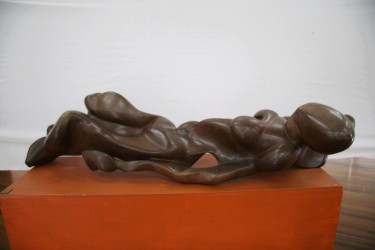Artists Stanley Greaves and Akima McPherson, in this their fourth Conversation, examine Gary Thomas’s sculpture, Retrogression. This piece, completed in 1975, is currently available for viewing in the first floor gallery and is part of the exhibition ‘Abstract Art in the National Collection Paintings and Sculpture’ which runs until July 18.
Stanley Greaves: Seeing this work the first impression was that it was presented horizontally as opposed to the standard vertical. The next and most striking feature was that the work seemed to deny the grain of the wood in the nature of its presentation. There was no “woodiness’ and the form could easily have been cast in bronze. I wondered about the title which to my mind did not seem to relate to the form.
Akima McPherson: The horizontality of the work did also strike me as unusual for local sculpture. I was additionally taken in by the abstract figuration – the form mimics a woman lying down, but the sensuality of the posture and the form does not seem to relate to the work’s title at all. Perhaps the absence of obvious relationship between the title and the work is a deliberate ploy by the artist to cause us viewers to look earnestly and question the work.

Gary Thomas
Mahogany
1975
SG: I was more attracted to the form looking like water flowing across a rock in a rapid. By going camping in the interior I saw many such forms. Thomas managed to capture this in a remarkable way. There is a lot of “frozen” movement in the piece. Observing it is like listening to music, and a dialogue is created between the form and your vision. I do not even know if you need a title in a work like this which is really all about form.
AM: The title in this case is a bit of a letdown for me. The work also reminds me of water’s effect with time on wood – a moment arrested after the passage of several thousand moments. I have not been privileged to see this effect on rocks; your association makes the work more exciting for me and allows me to see the poetry you see in it.
SG: The thing is that from travelling in the interior I have always been struck by the interesting variety of forms to be seen in nature. Great lessons for anyone interested in pure sculptural form, not necessarily realistic. We know that sculpture like painting can also be narrative. In the final analysis it depends on the personality of the artist. In Retrogression it is easy to forget the title and respond to the form itself with or without visual associations of the kind we have been referring to.
AM: Indeed, and I think this is where the possibility of enjoyment exists. In a work like this I like to look with my imagination – imaginatively allowing my hands to move with the contours of the form and crazy as it may seem, I sometimes imagine myself as a tiny being able to walk through and inhabit the spaces created by the artist’s form. In this way, I get to know the work in a unique kind of way that looking with the eyes does not allow.





